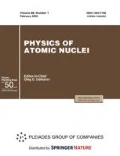Abstract
The seesaw mechanism, which explains the smallness of the neutrino masses by the involvement of high Majorana masses, leads to particles of the same Majorana nature and to a direct violation of the lepton number. A seesaw version entailing the appearance of only Dirac neutrinos subjected to the same kind of violation is proposed. Such a situation seems possible for heavy neutrinos coupled nonperturbatively to the Higgs boson \(H\). It is required for mirror neutrinos in a model that explains the structure of the quark and lepton weak-mixing matrices by the existence of very heavy mirror neutrinos analogous to Standard Model fermions. A nonperturbative character of the problem being discussed prevents the construction of an analytic solution to it, but the conditions deduced for this problem are indicative of a preferable appearance of precisely Dirac neutrinos within this mechanism. The phenomenon under discussion may be of importance for leptogenesis processes if all neutrinos are Dirac particles.


Similar content being viewed by others
Notes
For Dirac light particles, we have \(A=B\)—see [3], ‘‘corrigenda’’ in Phys. At. Nucl. or arXiv.
REFERENCES
R. N. Mohapatra and A. Yu. Smirnov, hep-ph/0603118; S. F. King et al., arXiv: 1402.4271 [hep-ph]; L. Maiani, arXiv: 1406.5503 [hep-ph].
L. B. Okun, Leptons and Quarks (North-Holland, Amsterdam, 1982, Nauka, Moscow, 1990).
I. T. Dyatlov, Phys. At. Nucl. 78, 485 (2015); arXiv: 1502.01501 [hep-ph].
I. T. Dyatlov, Phys. At. Nucl. 80, 679 (2017); arXiv: 1703.00722 [hep-ph]; Phys. At. Nucl. 82, 144 (2019); arXiv: 1812.02403 [hep-ph].
Particle Data Group (M. Takabashi et al.), Phys. Rev. D 98, 030001 (2018).
I. T. Dyatlov, Phys. At. Nucl. 80, 469 (2017).
V. A. Miransky, Nuovo Cim. A 90, 149 (1985).
C. N. Leung, S. T. Love, and W. A. Bardeen, Nucl. Phys. B 273, 649 (1986).
I. T. Dyatlov, Phys. At. Nucl. 81, 236 (2018); arXiv: 1802.00193 [hep-ph].
K. Moffat, S. Pascoli, S. T. Petcov, and J. Turner, arXiv: 1809.08251 [hep-ph]; K. Earl, C. S. Fing, T. Gregoire, and A. Tonato, arXiv: 1903.12192 [hep-ph].
Author information
Authors and Affiliations
Corresponding author
Rights and permissions
About this article
Cite this article
Dyatlov, I.T. Dirac Neutrinos in the Seesaw Mechanism: Violation of the Number of Dirac Neutrinos. Phys. Atom. Nuclei 83, 480–487 (2020). https://doi.org/10.1134/S1063778820030059
Received:
Revised:
Accepted:
Published:
Issue Date:
DOI: https://doi.org/10.1134/S1063778820030059



